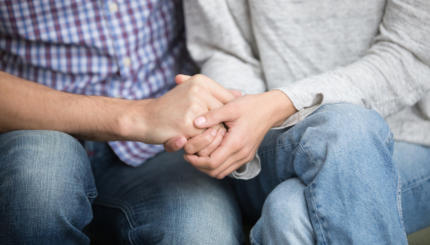At his first bar mitzvah back in 1946, Harold Gorvine didn’t get to read from the Torah or give a talk about the portion.
“All I did was recite the Haftarah,” he recalled. “And I don’t remember if there was a party afterwards.”
Shortly after his 83rd birthday, Gorvine had a do-over, of sorts: a second bar mitzvah, at P’nai Or, a Renewal congregation in Philadelphia, one of two synagogues where he and his wife are members. This time, the retired teacher — known as “Doc” to generations of students at the Philadelphia-area Akiba Hebrew Academy (now Jack Barrack Hebrew Academy) — chanted his portion, Ki Tavo, and gave a talk about the Torah portion, known as a d’var Torah. Meanwhile, his wife, children, grandchildren and many former students watched proudly.
Not to be confused with an adult bar/bat mitzvah, a ceremony for adults who never marked this rite of passage, the optional “second bar mitzvah” is an opportunity for older adults to reaffirm their commitment to Judaism and bring their loved ones together.

Help us keep Jewish knowledge accessible to millions of people around the world.
Your donation to My Jewish Learning fuels endless journeys of Jewish discovery. With your help, My Jewish Learning can continue to provide nonstop opportunities for learning, connection and growth.
While one can opt for this ceremony at any age, the most common age is 83. The reasoning is that it is 13 years after 70, the life expectancy described in Psalm 90: “The span of our life is 70 years, or, given the strength, 80 years; but the best of them are trouble and sorrow. They pass by speedily, and we are in darkness.”
Comparing the second bar mitzvah to the first one, Rabbi Avi Winokur who has presided over two such ceremonies at Philadelphia’s Society Hill Synagogue, an egalitarian congregation that uses Conservative liturgy, said: “This is not about your parents telling you to do something, it’s not about Hebrew school, it’s not about the culmination of these years of study and all the pressure and expectations associated with it. It’s really a free-will situation.”
Whereas a first bar or bat mitzvah, which traditionally takes place at age 13 — or 12 for girls in some traditional Jewish communities — marks one’s entry into Jewish adulthood, the age when one takes on ritual obligations and can be counted in a minyan, a second bar or bat mitzvah is tantamount to a renewal of vows.
Like a first bar or bat mitzvah ceremony — in which ritual expectations and the amount of preparation vary widely, though the rite frequently includes reading from the week’s Torah portion — there is no standard playbook for the second one. For celebrants who have been regularly leyning, or chanting from the Torah, for years, the new ceremony may merely require practicing the specific portion and preparing a d’var Torah, or a speech based on the weekly portion. Others may need to learn, or relearn, how to read from the Torah.
Rabbi Rachel Timoner, of Congregation Beth Elohim, a Reform synagogue in Brooklyn, N.Y., said her congregation hosted a double bar mitzvah: A longtime congregant celebrated his second bar mitzvah, at age 83, on the same day a 13-year-old member had marked his very own rite of passage.
“It was really meaningful,” she said. “It’s a beautiful way to make intergenerational links in a community and a beautiful way to honor a person reaching the milestone of age 83.”
Gorvine, who is especially proud that his oldest granddaughter also read from the Torah at his ceremony, said, “Having a second bar mitzvah was a celebration of my life as an American, as a Jew and as a Reconstructionist Jew.” (Gorvine had his bar mitzvah at a synagogue affiliated with the Renewal movement, but identifies as Reconstructionist, he said.)
In 1955, Ivy Ames was one of the first girls at her Fairlawn, N.J., Conservative synagogue to have a bat mitzvah —- thanks to her mother’s advocacy. She remembers little about it, other than it involved reading from the Haftarah at a Friday night Shabbat service.
Decades on, at age 75, she spent more than a year preparing for a second bat mitzvah. Together with five other women she participated in a weekly class at Temple Beth Am, a Reform congregation in Miami. Some of the women in the class had never studied Hebrew before, while others were brushing up. Recalling her original bat mitzvah, Ames said, “My mother told the rabbi, ‘Look, rabbi, you have four daughters and no sons, so you ought to consider” allowing the girls in the synagogue celebrate this rite of passage.
“I thought as an adult it would certainly be a more spiritual experience,” Ames said. “As a 13 year old preparing for the bat mitzvah was all social, a chance to meet with boys. This time, I wanted to gain a better understanding.”
The second bat mitzvah was a group ceremony, and Ames didn’t pick the date. But coincidentally, she ended up with the same Torah portion, Parshat Emor, that she’d had the first time around. “When they announced the day and the portion, I said it was bashert,” she said, using the Yiddish word for “meant to be.”



